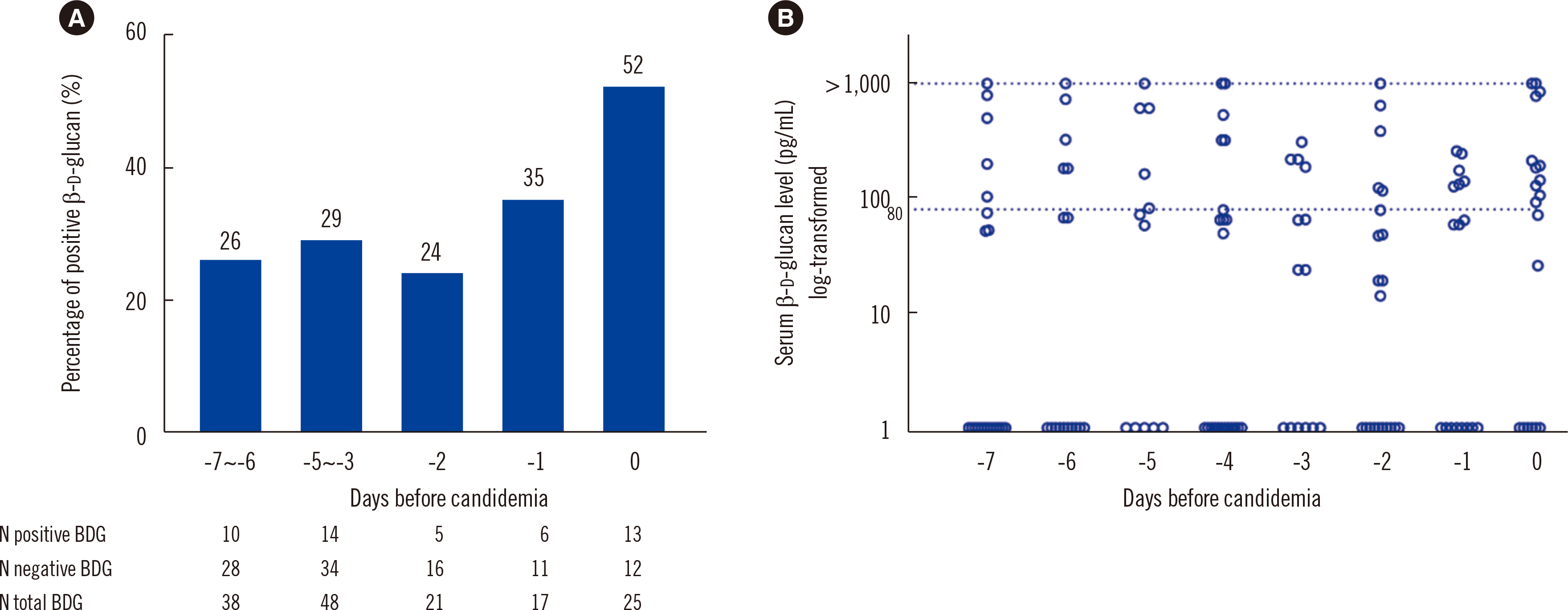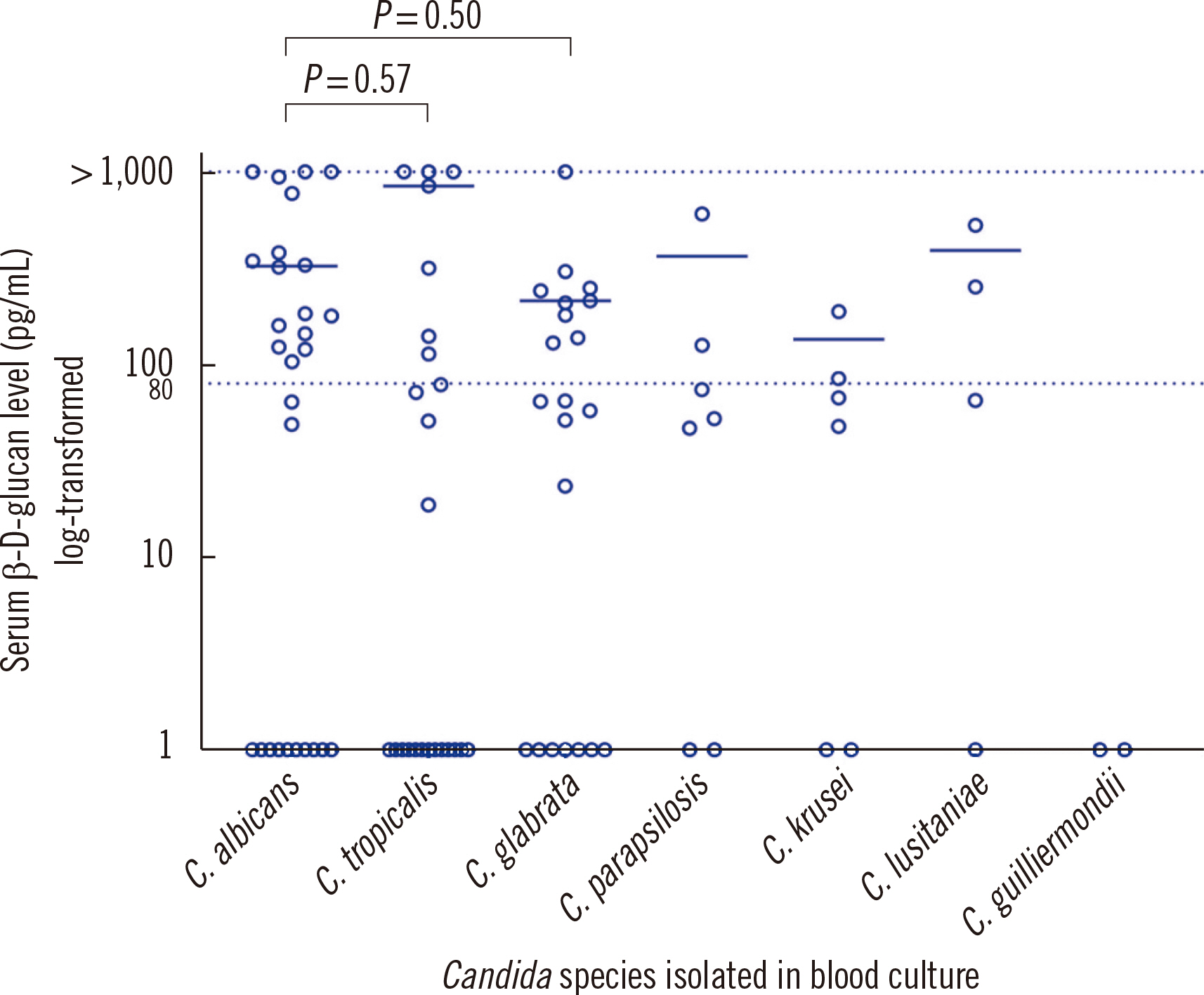Ann Lab Med.
2023 Jul;43(4):381-385. 10.3343/alm.2023.43.4.381.
Clinical Sensitivity of the (1–3)-β-D-glucan Test for Predicting Candidemia
- Affiliations
-
- 1Department of Infectious Diseases, Asan Medical Center, University of Ulsan College of Medicine, Seoul, Korea
- 2Department of Infectious Diseases, Kosin University Gospel Hospital, Busan, Korea
- 3Department of Infectious Diseases, Bumin Hospital, Seoul, Korea
- 4Department of Laboratory Medicine, Asan Medical Center, University of Ulsan College of Medicine, Seoul, Korea
- KMID: 2551956
- DOI: http://doi.org/10.3343/alm.2023.43.4.381
Abstract
- The sensitivity of the (1–3)-β-D-glucan (BDG) diagnostic test for candidemia varies in different clinical settings, and its usefulness in early diagnosis of candidemia is suboptimal. We evaluated the sensitivity of the test for early candidemia prediction. All adult patients with culture-proven candidemia who underwent a serum Goldstream Fungus (1–3)-β-D-Glucan Test within seven days prior to candidemia onset at a tertiary referral hospital between January 2017 and May 2021 were included. Any-positive BDG results within seven days prior to candidemia onset were obtained in 38 out of 93 (40.9%) patients. The positive rate increased when the test was performed near the day of candidemia onset (P=0.04) but reached only 52% on the day of candidemia onset. We observed no significant differences between BDG-positive and -negative groups in terms of underlying disease, risk factors for candidemia, clinical presentation, origin of candidemia, and 30-day mortality. Candida albicans was significantly associated with positive BDG results than with all-negative BDG results (P=0.04). The Goldstream BDG test is unreliable for candidemia prediction because of its low sensitivity. Negative BDG results in patients with a high risk of invasive candidiasis should be interpreted with caution.
Keyword
Figure
Reference
-
1. Falagas ME, Apostolou KE, Pappas VD. 2006; Attributable mortality of candidemia: a systematic review of matched cohort and case-control studies. Eur J Clin Microbiol Infect Dis. 25:419–25. DOI: 10.1007/s10096-006-0159-2. PMID: 16773391.
Article2. Tsay SV, Mu Y, Williams S, Epson E, Nadle J, Bamberg WM, et al. 2020; Burden of candidemia in the United States, 2017. Clin Infect Dis. 71:e449–53. DOI: 10.1093/cid/ciaa193. PMID: 32107534.
Article3. Colombo AL, Guimarães T, Sukienik T, Pasqualotto AC, Andreotti R, Queiroz-Telles F, et al. 2014; Prognostic factors and historical trends in the epidemiology of candidemia in critically ill patients: an analysis of five multicenter studies sequentially conducted over a 9-year period. Intensive Care Med. 40:1489–98. DOI: 10.1007/s00134-014-3400-y. PMID: 25082359. PMCID: PMC4176831.
Article4. Alam FF, Mustafa AS, Khan ZU. 2007; Comparative evaluation of (1, 3)-β-D-glucan, mannan and anti-mannan antibodies, and Candida species-specific snPCR in patients with candidemia. BMC Infect Dis. 7:103. DOI: 10.1186/1471-2334-7-103. PMID: 17784947. PMCID: PMC2075513.5. Clancy CJ, Nguyen MH. 2013; Finding the "missing 50%" of invasive candidiasis: how nonculture diagnostics will improve understanding of disease spectrum and transform patient care. Clin Infect Dis. 56:1284–92. DOI: 10.1093/cid/cit006. PMID: 23315320.
Article6. Nucci M, Nouér SA, Esteves P, Guimarães T, Breda G, de Miranda BG, et al. 2016; Discontinuation of empirical antifungal therapy in ICU patients using 1,3-β-D-glucan. J Antimicrob Chemother. 71:2628–33. DOI: 10.1093/jac/dkw188. PMID: 27287231.
Article7. Kritikos A, Poissy J, Croxatto A, Bochud PY, Pagani JL, Lamoth F. 2020; Impact of the beta-glucan test on management of intensive care unit patients at risk for invasive candidiasis. J Clin Microbiol. 58:e01996–19. DOI: 10.1128/JCM.01996-19. PMID: 32238435. PMCID: PMC7269378.
Article8. Martínez-Jiménez MC, Muñoz P, Valerio M, Alonso R, Martos C, Guinea J, et al. 2015; Candida biomarkers in patients with candidaemia and bacteraemia. J Antimicrob Chemother. 70:2354–61. DOI: 10.1093/jac/dkv090. PMID: 25900160.9. Karageorgopoulos DE, Vouloumanou EK, Ntziora F, Michalopoulos A, Rafailidis PI, Falagas ME. 2011; β-D-glucan assay for the diagnosis of invasive fungal infections: a meta-analysis. Clin Infect Dis. 52:750–70. DOI: 10.1093/cid/ciq206. PMID: 21367728.
Article10. Son HJ, Sung H, Park SY, Kim T, Lee HJ, Kim SM, et al. 2017; Diagnostic performance of the (1-3)-β-D-glucan assay in patients with Pneumocystis jirovecii compared with those with candidiasis, aspergillosis, mucormycosis, and tuberculosis, and healthy volunteers. PLoS One. 12:e0188860. DOI: 10.1371/journal.pone.0188860. PMID: 29190812. PMCID: PMC5708637.11. Guitard J, Isnard F, Tabone MD, Antignac M, Brissot E, Senghor Y, et al. 2018; Usefulness of β-D-glucan for diagnosis and follow-up of invasive candidiasis in onco-haematological patients. J Infect. 76:483–8. DOI: 10.1016/j.jinf.2018.01.011. PMID: 29432826.
Article12. Pfeiffer CD, Samsa GP, Schell WA, Reller LB, Perfect JR, Alexander BD. 2011; Quantitation of Candida CFU in initial positive blood cultures. J Clin Microbiol. 49:2879–83. DOI: 10.1128/JCM.00609-11. PMID: 21677065. PMCID: PMC3147732.
Article13. Posteraro B, De Pascale G, Tumbarello M, Torelli R, Pennisi MA, Bello G, et al. 2011; Early diagnosis of candidemia in intensive care unit patients with sepsis: a prospective comparison of (1→3)-β-D-glucan assay, Candida score, and colonization index. Crit Care. 15:R249. DOI: 10.1186/cc10507. PMID: 22018278. PMCID: PMC3334800.14. Kazancioglu S, Bastug A, Kayaaslan B, Mutlu NM, Calci E, Turhan T, et al. 2022; Diagnostic value of β-D-glucan alone or combined with Candida score, colonization index and C-reactive protein for candidemia. J Infect Dev Ctries. 16:362–8. DOI: 10.3855/jidc.15711. PMID: 35298433.
Article15. Mikulska M, Giacobbe DR, Furfaro E, Mesini A, Marchese A, Del Bono V, et al. 2016; Lower sensitivity of serum (1,3)-β-D-glucan for the diagnosis of candidaemia due to Candida parapsilosis. Clin Microbiol Infect. 22:646.e5–8. DOI: 10.1016/j.cmi.2016.05.020. PMID: 27256062.16. Farooqi J, Niamatullah H, Irfan S, Zafar A, Malik F, Jabeen K. 2021; Comparison of β-D-glucan levels between Candida auris and other Candida species at the time of candidaemia: a retrospective study. Clin Microbiol Infect. 27:1519.e1–5. DOI: 10.1016/j.cmi.2021.05.031. PMID: 34111581.17. Angebault C, Lanternier F, Dalle F, Schrimpf C, Roupie AL, Dupuis A, et al. 2016; Prospective evaluation of serum β-glucan testing in patients with probable or proven fungal diseases. Open Forum Infect Dis. 3:ofw128. DOI: 10.1093/ofid/ofw128. PMID: 27419189. PMCID: PMC4942764.
Article18. Theel ES, Doern CD. 2013; β-D-glucan testing is important for diagnosis of invasive fungal infections. J Clin Microbiol. 51:3478–83. DOI: 10.1128/JCM.01737-13. PMID: 23850953. PMCID: PMC3889722.
Article
- Full Text Links
- Actions
-
Cited
- CITED
-
- Close
- Share
- Similar articles
-
- The Effectiveness of (1,3)-β-D-Glucan Assay for Diagnosis of Invasive Fungal Infections in Patients with Burn Injury
- Clinical Significance of Pastorex Candida Antigen Assay in Patients with Candidemia
- Time to Positivity of Peripheral Blood Culture in Candidemia
- A clinical analysis of 27 patients with candidemia
- Risk Factors for the Development of Nosocomial Candidemia among Patients in Intensive Care Unit



